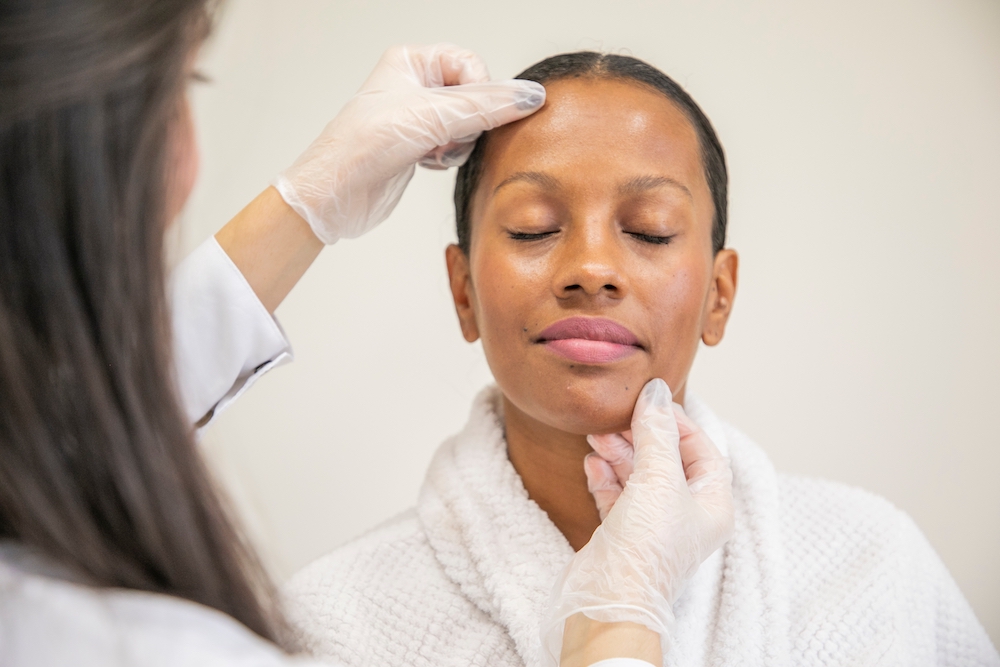For clients who have never had a facial treatment before, a relaxing hour with a therapist can quickly become their worst nightmare when they experience "skin purging".
Whilst it doesn’t happen to every client, or after every treatment, “skin purging” is a very real and common after-effect of treatments, especially for clients who use minimal active ingredients in their day-to-day routine, and those who are not regular with facial treatments.
However, with clients investing both time and money into facials, how can you set clear expectations?
What does skin purging mean?
“Skin purging is a temporary reaction of the epidermis that can occur when a new topical skincare product is used, or treatment regime begins,” explains chemical engineer, skincare formulator and founder of Skin Masterclass, Cigdem Kemal Yilmaz.
“It’s a type of inflammatory acne that presents itself when an increase in cell turnover occurs,” continues Pandora Long, founder of Pandora Long Aesthetic Facials.
“As a result, any excess sebum, hidden imperfections, or build-up of debris is pushed to the surface, resulting in breakouts and occasionally skin peeling.”
What causes the skin to purge?
It can be hard to pinpoint exactly what causes the skin to purge, as one hundred different clients could have one hundred different triggers.
“Skin purging can be caused by any active ingredient that has the potential to increase cell turnover rate – most of which are used in anti-ageing, anti-acne and exfoliating products,” explains Long.
“A common example of this are Vitamin A derivatives, such as retinol, retinoids and tretinoin. Some other ingredients include AHAs, BHAs and Vitamin C.”
Andrea O’Donnell, clinical educator for Inmode, adds that, “It’s important to note that not everyone will experience purging when using these ingredients mentioned, and it’s also possible to have an adverse reaction to an ingredient that’s not mentioned.”
More intensive beauty treatments, like microneedling, laser, and chemical peels that contain a level of active ingredients or methods that speed up cell turnover can also lead to skin purging.
Use of these treatments and products on your clients are often unavoidable, as Long explains, “They [the treatments and products] can combat many imperfections and concerns such as fine lines, wrinkles, scarring, pigmentation and existing breakouts; and by that very nature there is a risk that sometimes these treatments may result in purging.”
How to identify a purge vs a breakout
“Timing is key when establishing the difference between skin purging and acne,” explains Kemal Yilmaz.
“Skin purging is very much a temporary phenomenon and will take four-to-six weeks to clear whilst a condition such as acne will persist.”
Long agrees that four-to-six weeks is an accurate marker for purges, adding, “If your clients’ breakouts are lasting longer then it may just be that their skin isn’t compatible with the new product, or perhaps something else is the root of the cause and they should consult a professional.
“Additionally, if you find your clients breaking out in areas that they’ve never really had issues with before, this could indicate a true breakout rather than a purging breakout.”
Can skin purging be avoided?
Unfortunately, skin purging is pretty unavoidable during intensive treatments as the blockages are already within the skin, with the treatment just speeding up their appearance.
“If blockages are lying dormant under the skin and you start to use certain actives then it is likely these will come to the surface at some point,” explains Long.
Don’t be discouraged, though, because there is a way to minimise the effects.
“A lot of the time, purging can be avoided by ensuring that the skin’s barrier remains uncompromised by introducing one active ingredient at a time,” Long says.
If you have a client booked in for an intensive treatment, have the prep ahead of their appointment by slowly adding actives to their routines at home.
Long recommends explaining to the clients that, “You can also start by introducing this ingredient a few times a week until your skin is happy with daily use.”
Skin cycling is a great way to slowly incorporate new products into a routine, without flooding the skin.
How to set expectations for clients
For clients who haven’t experienced purging before – especially those who are coming to you for their first ever treatment – waking up to find a breakout can be disheartening. This is where your education and knowledge come in.
“Clients who are having treatments to improve the condition of their skin may find the concept of skin purging counterintuitive. However, it’s important for skin professionals to give sound, honest and frank advice so that client expectations are managed and so that they know how to identify skin purging should it occur,” explains Kemal Yilmaz.

“It is really important to warn that purging is a possibility when it comes to certain treatments, but also to educate them that purging isn’t necessarily a bad thing!” shares Long.
“While nobody wants to have any form of pimples, a purge can indicate that the treatment is working as it’s supposed to by speeding up cell turnover and allowing those new, fresh skin cells to come to the surface.
“Increasing cell turnover has been proven to be so effective in preventing the manifestations of ageing, and also acne, so you can phrase it to your clients as a small sacrifice for a long-term result of smoother, brighter and younger skin.”
“Let clients know that purging is a common occurrence and can happen when active ingredients in skincare products cause the skin to expel impurities,” adds O’Donnell.
“Explain that purging is a natural and necessary process for the skin to heal and regenerate.”
Aftercare for clients
For clients who have experienced skin purging following a treatment, there are a number of tips and tricks you can recommend post treatment to help minimise the effects and move past the purge.
“Similarly to how you would recommend your client to treat other breakouts, it is important they make sure to resist the urge to treat the area with even more actives which can strip the skin’s barrier and make it worse,” explains Long.
For clients wishing to experience a true purge, bringing all the underlying blockages to the surface and out of the skin, Long encourages clients to “continue to use the active ingredient whilst balancing their regime with some hydrating, restoring products, as purging can also cause slight irritation and dryness”.
As with most things when it comes to skincare, a good routine is key.
“A robust cleansing regimen using a mild, hydrating cleanser is also beneficial,” recommends Kemal Yilmaz, adding, “Water should be lukewarm so as not to dehydrate the skin further.”
Like for the majority of treatments, Yilmaz also recommends avoiding the sun where possible, as she explains, “Sun exposure can worsen skin purging, so wearing a good quality, broad-spectrum sun protection product with a minimum of SPF 30 is crucial to avoid any further inflammation, UV damage and free radical attack.”




